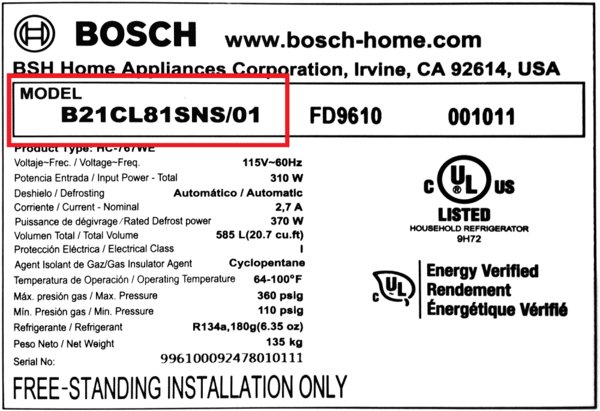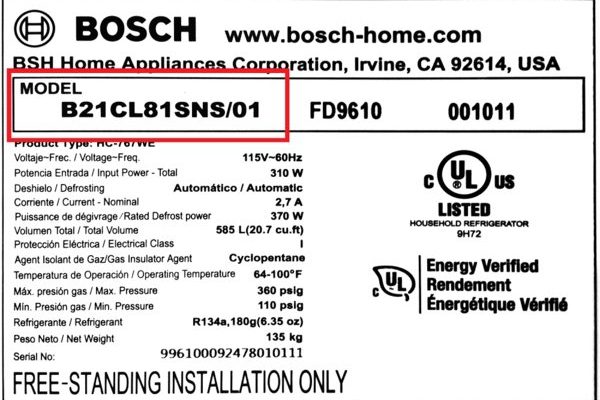
Honestly, I get it. Bosch is known for making reliable laundry appliances. But they sure don’t make that serial number stand out in flashing lights. If you’re standing in your laundry room, phone in hand, feeling a little lost—let’s make this simple. By the end of this, you’ll know *exactly* where to look, how to read the code, and what to do if that number isn’t playing nice.
Why the Serial Number Matters for Bosch Laundry Appliances
Here’s the thing—think of your Bosch washer or dryer’s serial number as its passport. It tells Bosch exactly who your machine is, where and when it was made, and all the official details that prove you own it. This isn’t just paperwork for the sake of paperwork. If your appliance needs a repair, or if you want to activate that sweet Bosch warranty, the serial number is essential.
Bosch, like most brands, uses serial numbers to help you:
- Register the product for warranty
- Order matching parts
- Schedule authentic repairs
- Track recall notices
Think of it as your Bosch machine’s special code for tech support and troubleshooting. Without it, customer service reps are working blind, and you might miss out on free repairs or replacements.
What Does a Bosch Serial Number Look Like?
Let me break down what you’re looking for. Bosch laundry appliance serial numbers usually have 10 or more numbers and letters. They might be called out as “Serial,” “S/N,” or “E-Nr” (which stands for Engineering Number). And, yes—it’s easy to mix these up!
Typically, a Bosch serial number might look something like this: FD 9903 200123 or S/N: 980312345. The “FD” code is a big clue. It stands for “Fertigungsdatum,” which is just a fancy German word for “production date.” That’s Bosch being fancy—don’t let it throw you off.
The serial number might be stamped on a sticker, printed on a metal plate, or sometimes laser-etched in a corner. And depending on whether you have a washer or dryer, the location can change.
Common Serial Number Locations on Bosch Washers and Dryers
At this point, you’re probably wondering: Where do I actually look? Here’s where Bosch likes to hide those numbers:
- Inside the door or lid – Open the washer or dryer door. Look around the frame where the door meets the machine. You might see the label on the rim or just inside the casing.
- On the side panel – Some models (especially dryers) will have the serial number sticker on the inside edge of the side panel—usually on the left or right when you open the door.
- Back of the machine – For older Bosch laundry appliances, check the back panel near where the cords and hoses connect. You’ll need to pull it out a little—so be careful not to mess with the hookups.
- Behind the detergent drawer – Slide out the detergent drawer (the part you fill with soap or softener). Look along the edge or back wall of the compartment.
If you’re stuck, shine a flashlight and check for a white or silver label with barcodes. You might spot both a model number and serial number side by side.
Step-By-Step: How To Find the Serial Number for Warranty Registration
Let’s break this down so you can get it done without breaking a sweat—or a fingernail.
Step 1: Unplug the Appliance (Safety first! Especially if you’re sliding or tilting your machine.)
Step 2: Open the Door or Detergent Compartment. If you have a front-loader, the door frame is the prime spot. With a top-loader, check under the lid or the back edge.
Step 3: Look for a Label or Sticker. The label should have several numbers and barcodes. Look for phrases like “Serial Number,” “S/N,” or “FD.”
Step 4: Snap a Photo. It’s easier to zoom in on your phone if the print is tiny (and it usually is).
Step 5: Write It Down. Copy the number onto your warranty registration form or Bosch’s website. Double-check for typos—Bosch’s system is picky about correct numbers.
If you don’t find it on the first try, don’t panic. Give each area a close look. Those labels can hide in plain sight!
What To Do If the Bosch Serial Number Label Is Missing or Damaged
Sometimes, the label just isn’t there. Maybe it fell off, got scrubbed away by too many cleanings, or faded over time. Here’s what you can do:
- Check the Original Purchase Paperwork – Retailers often note the serial number on your sales receipt, warranty card, or delivery papers.
- Look at the User Manual – Sometimes there’s a sticker or handwritten note inside the manual from when the appliance was installed.
- Contact Bosch Support – Bosch customer service may be able to use your model number, purchase date, and dealer info to help you register—even if the serial number is hard to read. Be honest—they’ve seen it all before!
If all else fails, having the E-Nr (model or engineering number) handy can help the process. The more info you have, the better support they can give.
Understanding Bosch Model, E-Nr, and FD Codes
This is where Bosch gets a little technical, so let me explain. You’ll see three different codes:
- Model Number (sometimes called Type or Product Number): Tells you the family/type of machine (like WAW285H2UC/12 for washers).
- E-Nr (Engineering Number): A unique code for the exact build and features of your appliance.
- FD Code: Stands for the production date (month/year). Sometimes paired right next to the serial number.
When Bosch’s warranty team asks for the serial number, they usually want all three, just to be sure. Don’t get them mixed up. Pay close attention to the label’s layout and double-check before entering anything online.
Tips for Registering Your Bosch Laundry Appliance for Warranty
Once you’ve found that elusive serial number, it’s time to register. Here’s how to keep the process stress-free:
- Go online – Visit Bosch’s official warranty registration page. Fill in your details, the machine’s codes, and proof of purchase if needed.
- Use the right code – Double-check whether the site wants the “serial number,” “FD,” or “E-Nr.” Bosch isn’t always clear, so have all three ready just in case.
- Keep records – After registering, save a digital copy of your confirmation. If you need warranty service, this makes things ten times easier.
- Don’t wait too long – Some Bosch warranties have a window (like 30 or 90 days from purchase) for registration. The sooner you do it, the better.
If you get an error message, double-check for typos or try a different code format. Bosch’s site can be fussy, so patience and persistence pay off.
Comparing Bosch Serial Number Locations with Other Brands
You might be wondering how Bosch stacks up against, say, GE or LG. Honestly, most laundry appliance makers follow similar “hide-and-seek” rules for serial numbers. But each has its quirks.
- Bosch – Door frame, side panel, detergent drawer, or back panel.
- GE – Usually on the inside of the door or back panel (just like Bosch).
- LG/Samsung – Often on the door rim or behind the detergent drawer, but sometimes use QR codes for easy scanning.
Bosch doesn’t use QR codes as often yet, so you’re stuck with the old-school method for now. If you ever upgrade in the future, keep this in mind!
Final Thoughts: Make Your Bosch Warranty (and Laundry Life) Easier
Taking a few extra minutes to hunt down your Bosch laundry appliance’s serial number pays off big time. You’ll breeze through warranty registration, future troubleshooting, and part ordering without all the headaches. Next time you need to sync up with Bosch for support or repairs, you’ll already have all the secret codes ready.
It might feel like a tiny detail, but when your washer suddenly needs fixing or your dryer starts making odd noises, you’ll be glad you took the time. Keep a photo or note of your serial number somewhere safe. That’s one less thing to worry about when laundry day comes around again.
